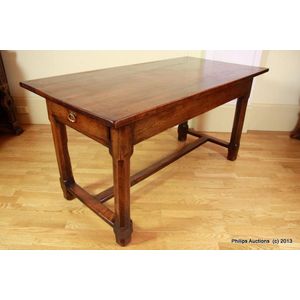Solid Plank Top Refectory Table with Chamfered Trestle Ends
You must be a subscriber, and be logged in to view price and dealer details.
Subscribe Now to view actual auction price for this item
When you subscribe, you have the option of setting the currency in which to display prices to $Au, $US, $NZ or Stg.
- Stretcher - A horizontal rail which connects the legs of stools, chairs, tables and stands, to provide stabilisation of the legs. A stretcher table is any table with a stretcher base. The term is usually applied to substantial farmhouse tables, although many cabinetmaker's pieces, such as sofa tables, also have turned stretchers.
- Refectory Table - A long, substantial, solid-topped table, without leaves or extensions, used as a dining table. They were originally used in the refectories, or dining halls of monasteries, and are found in such places as boarding schools and university halls of residence. The tables usually have heavy turned legs, sometimes connected by stretchers close to the floor, and often have additional supporting legs along the railed frame. The term is also sometimes applied to a much shorter solid-topped table with a somewhat Jacobean flavour of the early 20th century.
- Trestle Table - The medieval table was usually a loose board, placed on removeable folding supports called trestles. In the 16th century, trestles fixed to the top of the table were introduced at each end of the frame, each resting on a broad base or foot, often connected and supported by one or two stretchers.
- Bevel / Chamfer - In furniture making, a chamfered corner refers to a technique used to create a smooth, angled edge on the corner of a piece of furniture. This is typically done by cutting away a small portion of the corner at an angle, typically 45 degrees, creating a diagonal edge, rather than a sharp 90-degree angle. This technique can be used on various parts of a piece of furniture such as table legs, drawer fronts, or door frames. Chamfering can add visual interest to a piece and can help to soften the overall look of a piece of furniture. It is often used in conjunction with other techniques, such as rounding edges or using contrasting wood species to create a more elegant, sophisticated look. Chamfering is a simple way to add a touch of elegance to a piece of furniture and it is a common technique used by furniture makers.
This item has been included into following indexes:
Visually similar items

A small restored French elm farm table, 18th century and later, with a planked top above an apron with two end drawers with oval brass ring handles, chamfered square pegged legs united by an 'H' form stretcher base. Height 75 cm. Length 150 cm. Width 74 cm

Antique English Regency mahogany wash stand, standing on multi ring turned slender legs, fitted with deep splash back, approx 101 cm high, 92 cm wide, 41 cm deep

George III mahogany side table with bow fronted top and single drawer on tapered square legs, 81.5 cm wide, 42 cm deep, 74 cm high

A French Art Deco walnut extension table and six chairs, circa 1925, with three leaves original to the table, the octagonal extension table some facets having bold relief carved stylised flora, upon a square pedestal base supported by four reeded legs; the
